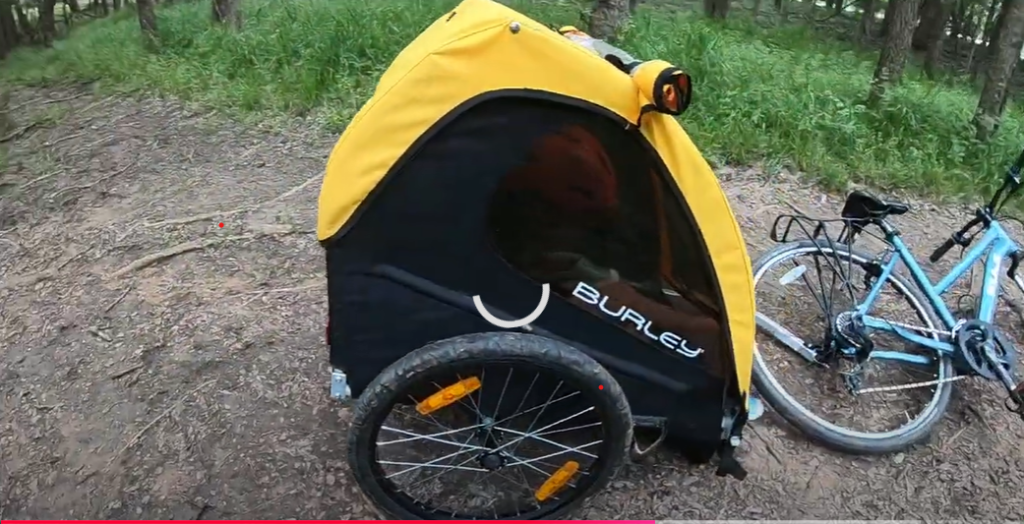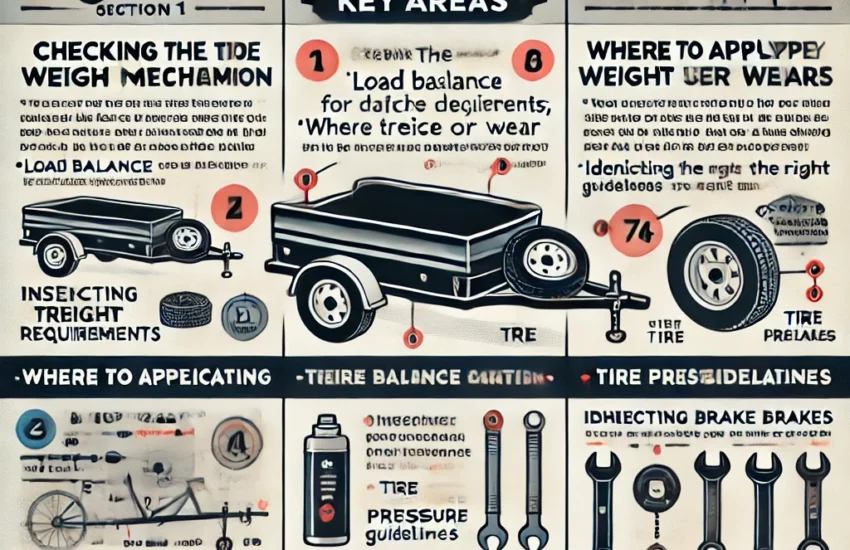Regular bike trailer maintenance checklist reduces repair costs by as much as 75% annually. In fact, 82% of trailer failures are preventable with consistent maintenance. Load-bearing components, such as axles and wheels, can last 2.5 times longer when properly serviced on a scheduled basis.
The average annual trailer repairing cost ranges between $50 and $150, while emergency repairs without proper upkeep can escalate to $200-$600.
Essential Tools for Bike Trailer Maintenance
Proper bike trailer maintenance requires a range of tools, from basic to advanced repairs.
Basic Tools You’ll Need
- Wrenches and Socket Set: To adjust bolts, particularly for the wheels, hitch, and frame.
- Tire Pump: Ensures proper tire inflation, which is vital for safe operation and efficiency.
- Screwdrivers (Flathead & Phillips): For making adjustments to various fasteners on the trailer.
- Lubricants (Grease & Oil): Essential for keeping moving parts like bearings and axles well-lubricated.
- Pliers: Useful for gripping small components such as nuts and bolts during maintenance.
- Cleaning Supplies: Brushes, rags, and mild cleaners to maintain the trailer’s appearance and prevent buildup that can cause wear.
Specialized Tools for Advanced Repairs
- Bearing Puller: Necessary for replacing worn-out bearings, especially in the wheel hubs.
- Torque Wrench: Ensures that all bolts are tightened to the correct specifications, avoiding damage from over-tightening.
- Spoke Wrench: Important for adjusting wheel spokes to ensure they remain true and balanced.
Pre-Ride Bike Trailer Maintenance Checklist
It’s crucial to perform a quick pre-ride inspection of your bike trailer to ensure that everything is in safe, working condition. A simple inspection can prevent accidents, improve performance, and extend the lifespan of your trailer.
1. Checking the Hitch Mechanism
- Verify secure connection (pull test)
- Check safety chains are properly crossed
- Ensure locking pins are fully engaged
- Test hitch movement for proper rotation
- Confirm 10-15% tongue weight
Quick Fact: 65% of trailer accidents are linked to faulty hitch connections.
2. Inspecting the Tires for Damage or Wear
- Check pressure (ideal: 45-65 PSI)
- Examine tread depth (minimum 2/32″)
- Look for visible damage or bulges
- Verify even wear patterns
- Test valve stems for leaks
Safety Stat: Proper tire maintenance reduces accidents by 75%.
3. Ensuring Proper Weight Distribution
Load Balance Requirements
- Front/back: 60/40 split
- Side-to-side: Even distribution
- Maximum load: Stay within 85% capacity
- Center of gravity: Keep low and centered
Key Fact: Proper weight distribution improves stability by 80%.
Tire Maintenance
Proper tire maintenance is essential for safe and efficient bike trailer operation. Ensuring tires are in good condition can prevent accidents and improve trailer performance.

Tire Pressure Guidelines
Maintaining the correct tire pressure is crucial for safety, efficiency, and tire longevity:
- Check Pressure Regularly: Tires should be inflated to the manufacturer’s recommended pressure, typically between 30-50 psi. Incorrect pressure can cause instability and reduce handling.
- Under-Inflation: Under-inflated tires can result in poor handling. Tires that are under-inflated by 10-20% can reduce load capacity, increase rolling resistance, and cause wear 30% faster.
- Over-Inflation: Over-inflated causesvless grip and comfort, can lead to blowouts and decrease traction. Keep tire pressure within the specified range for optimal performance.
Identifying Tire Wear and Tear
Inspect your tires regularly for signs of damage or excessive wear:
- Tread Wear: Check for thinning or uneven tread. Worn-out tires reduce grip and are 50% more likely to cause accidents.
- Cracks or Cuts: Inspect sidewalls for cracks or cuts. These can lead to sudden tire failure, and tires with visible damage are 3 times more likely to fail.
- Bald Spots: Smooth, bald areas indicate worn-out tires that need replacing. Replace tires when tread depth is below 2mm.
Replacing Worn Tires
If tires show signs of excessive wear, they should be replaced immediately:
- Don’t Delay Replacement: Worn tires significantly increase the risk of blowouts and accidents. Replacing tires when they are worn out reduces failure risks by 70%.
- Choose Quality Tires: Invest in durable, high-quality tires designed for trailer use, which can last up to 2-3 years with proper care.
Lubricating Trailer Parts
Proper lubrication is essential for keeping your bike trailer running smoothly, preventing wear and tear, and extending its lifespan.
Why Lubrication is Critical
Lubrication reduces friction between moving parts, which helps to:
- Prevent Wear: Proper lubrication prevents metal components from grinding against each other, reducing wear and increasing the lifespan of parts by 30-50%.
- Reduce Maintenance Costs: Regular lubrication can cut down on repair costs by as much as 40%, as it prevents damage from friction-related issues.
Where to Apply Lubricant: Key Areas
Focus on these key areas when lubricating your trailer:
- Wheel Bearings: Lubricate the wheel hubs and bearings to reduce friction and ensure smooth rotation. Lack of lubrication here can cause wheel failure.
- Axles: Apply lubricant to the axles to prevent rust and corrosion, ensuring they turn freely and don’t seize up.
- Hitch Mechanism: Keep the hitch components (coupling and connection points) lubricated to ensure smooth attachment and detachment, reducing wear by up to 40%.
- Brake Components: If your trailer has brakes, lubricate the moving parts, such as the brake arms, to ensure they function properly and don’t seize, potentially improving braking performance by 30%.
- Joints and Moving Parts: Lubricate any joints or pivot points (such as folding mechanisms) to prevent stiffness and ensure smooth movement.
Choosing the Right Lubricant
The right lubricant depends on the specific trailer parts:
- Grease: Ideal for high-friction areas such as bearings, axles, and hitch mechanisms.
- Oil: Best for parts that require lighter lubrication, such as moving brake parts or joints.
- Dry Lubricant: Suitable for areas exposed to dirt or dust (such as chains), as it doesn’t attract debris.
- Silicone Lubricants: Great for preventing rust and corrosion on metal parts.
Maintaining Brakes on Bike Trailers
1. Drag Brakes
- Check Pads: Replace when they’re less than 2mm thick.
- Lubricate Moving Parts: Light lubrication to prevent wear, but avoid brake surface.
- Clean Brake Surface: Keep free from debris to maintain efficiency.
2. Disc Brakes
- Check Pads: Replace if below 2mm thick.
- Inspect Rotors: Clean regularly; replace if warped or scratched.
- Hydraulic Fluid: Check fluid levels for hydraulic brakes and replace every 1-2 years.
- Adjust Calipers: Ensure proper alignment with the rotor.
3. Rim Brakes
- Check Pads: Replace if below 2mm thickness.
- Inspect Rims: Ensure the brake track is not worn or damaged.
- Adjust Cables: Keep cables tight but not overly so for responsive braking.
4. Coaster Brakes
- Check Pedal Mechanism: Ensure smooth engagement and release.
- Lubricate Mechanism: Apply light lubricant to prevent resistance.
- Inspect Wheels: Look for signs of rubbing or resistance in the brake.
Inspecting Brake Pads and Cables
Regular inspection of the brake components ensures optimal performance:
- Brake Pads: Check for wear on the brake pads. Pads should have a minimum thickness of 2mm. If they are worn down, replace them to maintain effective braking power.
- Brake Cables: Inspect cables for signs of fraying, rust, or damage. Cables should be properly tensioned to ensure responsive braking.
- Brake Disc (if applicable): For trailers with disc brakes, check the brake rotors for warping, scoring, or contamination. Clean the rotor regularly with a brake cleaner to avoid reduced performance.
Adjusting or Replacing Brake Components
Adjusting and replacing brake components will ensure the system functions correctly:
- Brake Pad Adjustment: If the brake pads are too loose or too tight, they won’t work properly. Adjust them according to the manufacturer’s instructions to ensure they make proper contact with the wheel or rotor.
- Cable Tension: Tighten or loosen the brake cables to ensure they engage the brakes at the right time. Over-tightened cables can cause premature wear, while loose cables may result in insufficient braking.
- Replacing Worn Components: If any part of the brake system is worn out or damaged (pads, cables, discs), it’s important to replace them immediately.
Hitch and Tow Mechanism Maintenance
- Ensuring Secure Attachment: Always check that the hitch is firmly attached to the bike before each ride.
- Tightening Hitch Bolts: Regularly tighten bolts to prevent loosening, which can cause detachment.
- Lubricating the Hitch: Apply lubricant to the hitch connection to reduce friction and prevent rust.
Seasonal Bike Trailer Maintenance
Here’s a table summarizing the Seasonal Bike Trailer Maintenance:
| Maintenance Task | Winter Maintenance Tips | Preparing for Summer Use | Off-Season Storage Best Practices |
|---|---|---|---|
| Cleaning | Wash to remove dirt, salt, and grime to prevent corrosion. | Clean trailer to ensure it’s free of debris. | Clean and dry the trailer to avoid moisture buildup. |
| Lubrication | Apply lubricant to bearings, axles, and moving parts to prevent rust. | Lubricate hitch, bearings, and axles to keep parts functioning smoothly. | Lubricate parts before storage to prevent rust. |
| Tires | Inspect for damage, ensure proper inflation to prevent flat spots. | Check tire pressure and condition, and replace if needed. | Elevate trailer to prevent flat spots on tires. |
| Brakes | Check for rust or freezing issues; ensure smooth operation. | Test brake system and ensure it is functioning properly. | Ensure brakes are clean and functional before storing. |
| Storage | Store in a dry, cool place to protect from the cold. | Ensure the trailer is stored in a shaded, cool place to avoid excessive heat damage. | Store in a dry, cool, well-ventilated area, away from sunlight. |
| General Protection | Keep the trailer free of salt and moisture. | Inspect for any winter damage and replace worn-out parts. | Cover trailer to protect it from dust, dirt, and pests. |
Summary
Proper bike trailer maintenance is essential for safety and longevity. Regular checks on tires, brakes, lubrication, and the hitch ensure smooth and efficient performance. In winter, focus on cleaning, lubricating, and protecting against rust. Before summer, inspect and prepare the trailer by checking tire pressure and brake function. During off-season storage, keep the trailer in a dry, cool place, cover it, and elevate it to prevent damage. Seasonal maintenance helps extend the trailer’s life, reduce repair costs, and ensure safe, reliable use year-round.

